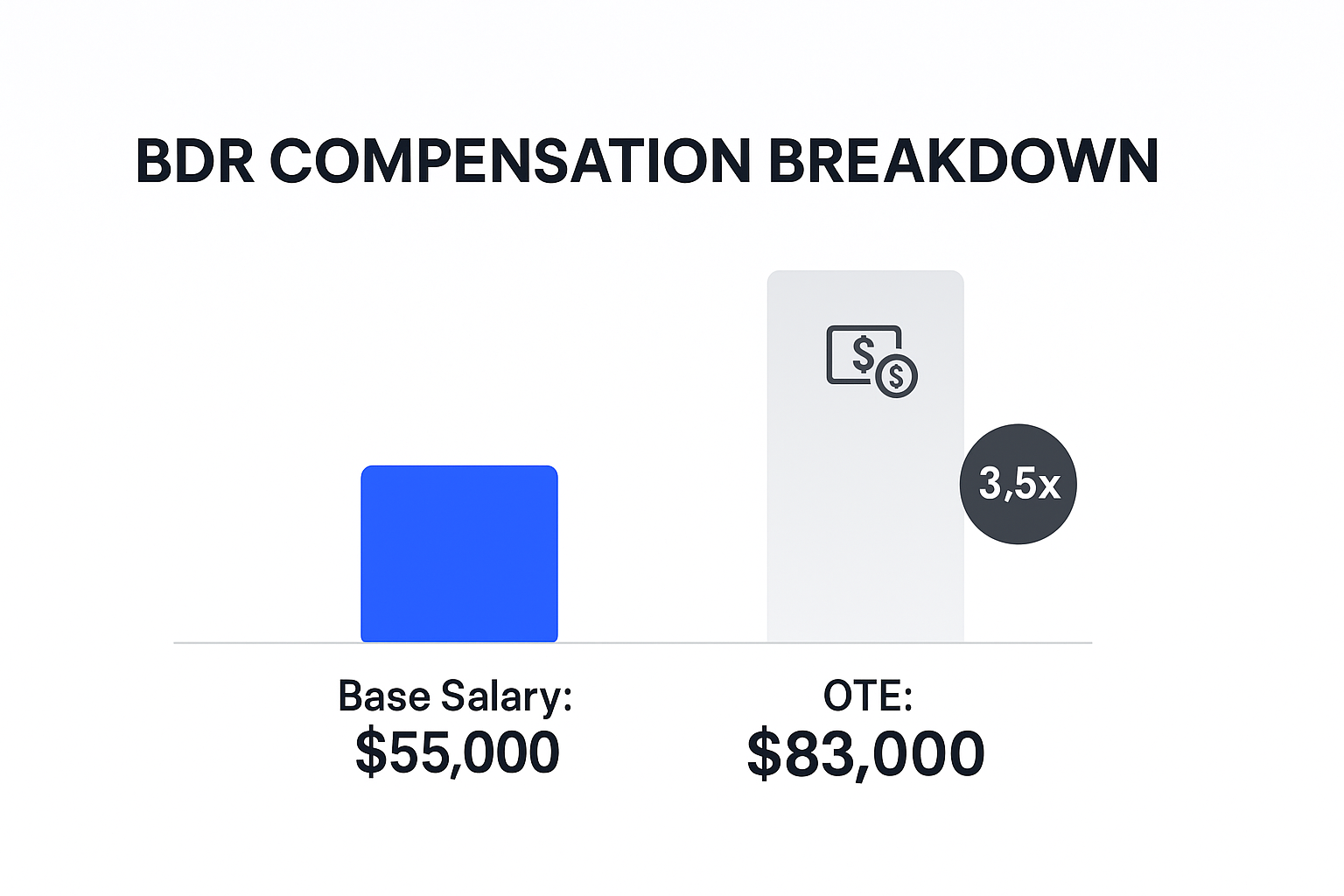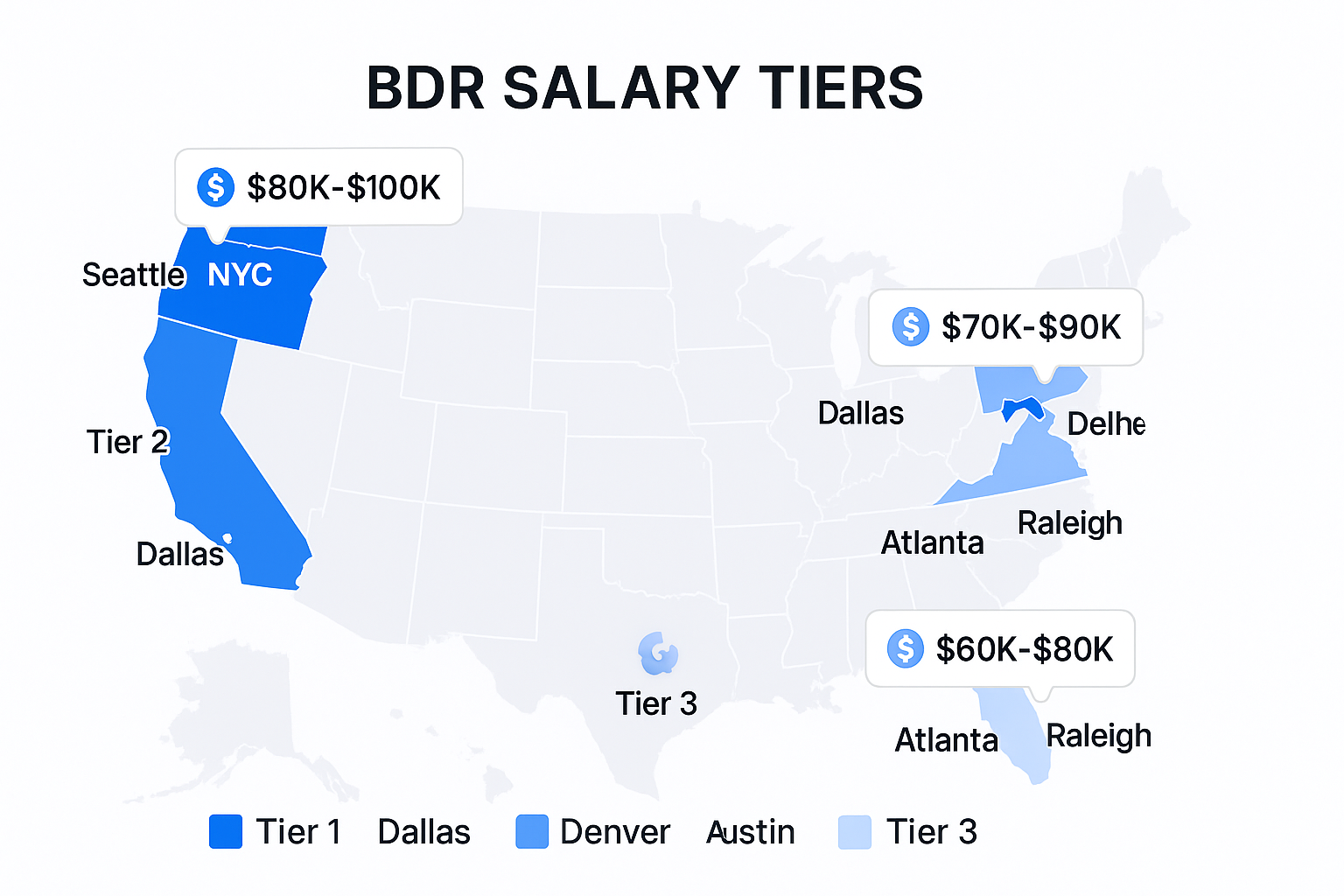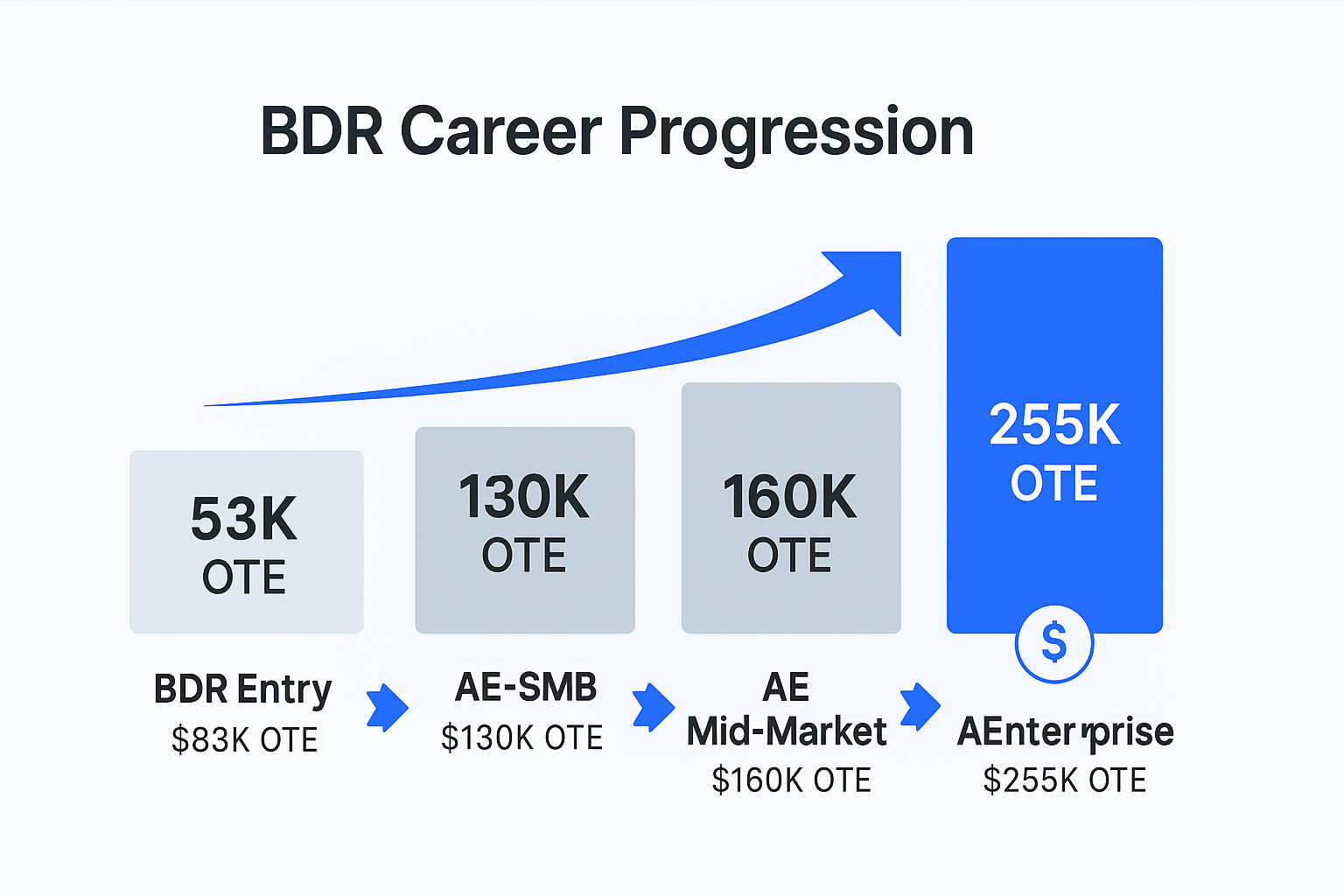- blog
- Statistics
- Business Development Rep Salary: 2025 Statistics & Benchmarks

Business Development Rep Salary: The Real Numbers Behind the Role in 2025
Table of Contents
Business Development Rep Salary
- Median base salary for BDRs is $55,000, with median OTE at $83,000 across national benchmarks
- Top BDR performers can earn $130,000+ through consistent quota overachievement and accelerators
- Seattle leads compensation with median OTE of $160,149 and average base of $73,598, highest in the nation
- San Francisco Bay Area pays base salaries averaging $79,900-$80,690 with median OTE around $126,536
- Remote BDR roles show average salary of $66,616, competitively above some major cities like Austin
- Entry-level BDRs (0-1 year) earn $70,000-$75,000 OTE with 70/30 base/variable pay mix
- Mid-level BDRs (1-3 years) earn $80,000-$90,000 OTE with 65/35 base/variable pay mix
- Senior BDRs (3-5+ years) earn $90,000-$100,000+ OTE with 60/40 base/variable pay mix
- Staying in BDR role beyond 3-5 years leads to wage stagnation with minimal salary growth
- Most BDR roles use 60/40 or 70/30 split (base/variable), with 70/30 more common for newer reps
- Activity-based commission pays around $150-$200 per demo or meeting for beginners focusing on volume
- Opportunity-based commission pays around $200 per Sales Accepted Opportunity (SAO) for mid-level reps
- Revenue-based commission pays 1-4% of contract value for advanced reps aligned with closed deals
- Average quota attainment rate is only 54%, meaning most BDRs don’t hit full number every month
- Promotion timeline has increased 28% post-pandemic, from 12 months to now 15-16 months on average
You’re scrolling through job postings. One says “$50K base.” Another promises “$80K-$100K.” A third mentions “competitive compensation” without any numbers at all.
Which one actually pays better?
Here’s the frustrating truth: most job listings hide the real earning potential of Business Development Representative roles. They focus on base salary and completely skip the variable pay that can make up 30-40% of your total compensation.
If you’re exploring this career path, negotiating an offer, or trying to figure out if you’re being paid fairly, you need real data. Not vague ranges. Not recruiter-speak. Just the numbers.
This guide breaks down exactly what Business Development Representatives earn in 2025, what factors move the needle on your paycheck, and how to use this information to your advantage. Whether you’re a skimmer who needs the highlights in 30 seconds or someone who wants the full breakdown, we’ve got you covered.
Let’s cut through the noise.
What is the Salary for a Business Development Representative?
Here’s what you actually need to know about compensation in this role.
The most important number to understand is On-Target Earnings (OTE). This is your base salary plus the variable compensation you earn when you hit 100% of your quota. It’s the real number that matters.
The national benchmarks for 2025:
- Median base salary: $55,000
- Median OTE: $83,000
- Top performers: $130,000+
These numbers come from verified employee data on platforms like RepVue, where actual reps report what they’re really making. Another source, BuiltIn, shows similar figures with an average total compensation of $91,397 (composed of $58,627 base and $32,770 in additional cash).
Now here’s where it gets interesting. If you look at job aggregator sites like ZipRecruiter, they report an average annual salary of only $59,559. That’s a $20,000+ gap from the real OTE numbers.
Why the huge difference?
Job postings typically only advertise base salary. They’re not lying, they’re just not telling you the whole story. That missing $20,000-$30,000? That’s your commission and bonuses—the money you earn by actually doing the job well.
Data Source | Median Base Salary | Median OTE | What It Measures |
RepVue | $55,000 | $83,000 | Verified employee reports |
BuiltIn | $58,627 | $91,397 | Anonymous employee data |
Salary.com | $63,970 | N/A | Employer-reported for “BDR I” level |
ZipRecruiter | N/A | $59,559 (avg) | Job posting data only |
The majority of salaries range from $26,500 on the low end to $95,500 on the high end, with elite performers breaking into six figures.
Bottom line: When evaluating any offer, always ask about OTE, not just base salary. If a company won’t tell you the OTE or seems vague about how the commission works, that’s a red flag.

What Factors Influence the Salary?
Not all Business Development Representative jobs pay the same. Your location, experience, and the structure of your compensation plan can swing your earnings by $40,000 or more. Here’s what actually moves the needle.
Location: Where You Work Changes Everything
Geography is the single biggest factor in your compensation. The same role can pay $50,000 in one city and $80,000 in another.
Tier 1: Major Tech Hubs (Highest Pay, Highest Cost of Living)
These cities pay top dollar, but your rent will make you cry:
- Seattle, WA: Leading the pack with a median OTE of $160,149 and an average base of $73,598. This is the best market for total earnings.
- San Francisco Bay Area: Base salaries average $79,900 in San Francisco and $80,690 in San Jose, with median OTE around $126,536.
- New York City: Base salaries range from $62,608 to $74,140, with total compensation hitting $87,175 to $99,348.
Tier 2: Growing Tech Cities (Strong Pay, Better Cost of Living)
These markets offer competitive salaries without completely destroying your budget:
- Dallas, TX: Base salary around $66,464 with competitive total comp
- Denver, CO: Base around $64,410 with total comp averaging $78,446
- Austin, TX: Base of $57,115 with median OTE of $111,696
- Chicago, IL: Average pay of $61,354, slightly above the national average
Tier 3: Emerging Markets (Solid Pay, Low Cost of Living)
Your dollar goes furthest here:
- Atlanta, GA: Base around $60,287
- Raleigh, NC: Base of $57,039
- Charlotte, NC: Base approximately $54,326
City | Tier | Average Base | Average OTE |
Seattle | 1 | $73,598 | $160,149 |
San Francisco | 1 | $79,900 | $126,536 |
New York | 1 | $63,564 | $99,348 |
Dallas | 2 | $66,464 | $124,564 |
Denver | 2 | $64,410 | $122,242 |
Austin | 2 | $57,115 | $111,696 |
Atlanta | 3 | $60,287 | $122,007 |
Raleigh | 3 | $57,039 | N/A |
The Remote Work Advantage
Here’s where things get really interesting. Remote roles now show an average salary of $66,616, which puts them competitively above some major cities like Austin.

💼 Tired of Location-Based Pay Limits?
LinkedIn outbound breaks geographic barriers—target decision-makers nationwide with our complete targeting system
Think about what this means: If you live in Raleigh but land a remote role with a San Francisco-based company, you could be earning $70K+ while your rent is half what it would be in the Bay Area. This is salary arbitrage, and it’s one of the biggest opportunities in 2025.
For companies, this creates a dilemma: Do you pay based on your HQ location, the employee’s location, or a national average? There’s no consensus yet, which means there’s room to negotiate.
Experience Level: Your Timeline to Better Pay
Your compensation grows with experience, but not forever. Here’s the realistic trajectory:
Entry-Level (0-1 Year): The Learning Phase
Fresh out of college or new to sales? Expect:
- OTE: $70,000-$75,000
- Base: $50,000-$61,000
- Pay mix: 70/30 (base/variable)
At this stage, you’re learning the fundamentals. Your job is to hit activity metrics—calls made, emails sent, meetings booked. Companies know you’re still figuring it out, so the base is higher relative to variable pay.
Mid-Level (1-3 Years): The Growth Zone
You know what you’re doing now. You’re hitting quota consistently. Your pay reflects it:
- OTE: $80,000-$90,000
- Base: $60,000-$65,000
- Pay mix: 65/35
This is where most people spend the bulk of their time in the role. You’re handling more complex outbound work, maybe mentoring newer reps, and consistently delivering qualified opportunities.
Senior (3-5+ Years): The Plateau
Here’s the hard truth: staying in an individual contributor role beyond 3-5 years leads to wage stagnation. The data shows minimal salary growth between the 2-4 year mark and the 5-8+ year mark.
- OTE: $90,000-$100,000+
- Base: $65,000-$70,000
- Pay mix: 60/40
People who reach this level and stay are often taking on team lead responsibilities or working strategic accounts. But the role itself doesn’t scale in value the way closing roles do.
🚀 Ready to Level Up Beyond BDR?
H2: Our LinkedIn campaign design converts cold prospects into booked meetings—scale your career faster
Experience | Average Base | Average OTE | Pay Mix | What You’re Doing |
0-1 Year | $50K-$61K | $70K-$75K | 70/30 | Learning fundamentals, activity focus |
1-3 Years | $60K-$65K | $80K-$90K | 65/35 | Consistent quota attainment, complex prospecting |
3-5+ Years | $65K-$70K | $90K-$100K+ | 60/40 | Strategic accounts, team lead duties |
The reality: If you want to maximize earnings, you need to move into a closing role (Account Executive) or sales leadership within 18-24 months. The individual contributor path has a ceiling.
Industry and Company Size
Not all companies pay the same, even for identical work:
Tech and SaaS companies pay the most. They understand that pipeline generation is the lifeblood of growth, and they’re willing to invest in talent.
Startups vs. Enterprise:
- High-growth startups often offer lower base but higher OTE with aggressive commission plans
- Enterprise companies provide more stability with higher base but potentially lower upside
- Startups might promote you faster (12-18 months)
- Enterprise might keep you in role longer (24+ months)
Commission Structure: How You Actually Get Paid
Your compensation plan determines how much of that OTE you’ll actually see. Here’s how the most common structures work:
Pay Mix: The Foundation
Most roles use either a 60/40 or 70/30 split (base/variable). This means:
- 70/30: $70,000 base, $30,000 variable = $100,000 OTE
- 60/40: $60,000 base, $40,000 variable = $100,000 OTE
The 70/30 is more common for newer reps. The 60/40 is typical once you’re more experienced.
Three Main Commission Structures:
Activity-Based (Best for Beginners)
- You get paid for actions: meetings booked, demos completed
- Example: $160 per completed demo or $200 per meeting held
- Typical quota: 10 demos per month
- Why it works: Teaches you to stay active and build good habits
Opportunity-Based (Most Common)
- You earn commission when you pass a qualified lead to sales
- Example: $200 per Sales Accepted Opportunity (SAO)
- Typical quota: 10-15 opportunities per month
- Why it works: Forces you to focus on quality, not just quantity
Revenue-Based (Advanced)
- You get a small percentage of the deal when it closes
- Example: 1-4% of the contract value
- Why it’s smaller: The Account Executive does the heavy lifting to close
- Why it works: Aligns you with the company’s real goal—revenue
Plan Type | Best For | Structure | Sample Quota | What You’d Earn |
Activity-Based | 0-6 months experience | $150/demo | 10 demos/month | $1,800 bonus if you book 12 |
Opportunity-Based | 6-24 months experience | $200/SAO | 12 SAOs/month | $2,600 bonus if you generate 13 |
Revenue-Based | 18+ months experience | 1% of revenue + $100/SAO | 12 SAOs/month | $3,300 if you generate 13 SAOs + $200K closes |
Accelerators: The Secret to Big Months
The best plans include accelerators—higher commission rates once you hit quota. Example:
- 0-100% of quota: Standard rate ($200 per opportunity)
- 101-150% of quota: 1.5x rate ($300 per opportunity)
This is how top performers hit $130,000+ years. They don’t just hit quota—they crush it.
What is the Role of a Business Development Representative?
Let’s be clear about what this job actually is.
You’re the engine of the sales pipeline. Your job is to find potential customers, figure out if they’re worth talking to, and get them on the phone with someone who can close the deal.
The core responsibility: Generate qualified opportunities through outbound prospecting and inbound lead follow-up.
What that actually means day-to-day:
- Research companies and find the right people to contact
- Send personalized cold emails (a lot of them)
- Make cold calls (yes, people still do this)
- Respond to inbound leads from the website, events, or webinars
- Run discovery calls to qualify if someone’s actually a good fit
- Book meetings for Account Executives
- Keep your CRM updated (tedious but critical)
Here’s the impact: Business Development teams generate between 30-45% of the total sales pipeline at typical SaaS companies. Without you, Account Executives would be scrambling to find their own leads. With you, they can focus entirely on closing.
This isn’t a glamorous role. You’ll hear “no” way more than “yes.” You’ll have days where nobody responds. But you’re learning the foundation of every sales skill that matters: research, targeting, messaging, qualification, and resilience.
What are the Missions?
Your main mission is simple but not easy: Generate a consistent flow of qualified opportunities every single month.
Typical monthly quotas: 10-15 qualified opportunities
What counts as “qualified” varies by company, but it usually means the prospect:
- Has a real problem your product solves
- Has the budget to buy
- Has the authority to make (or influence) the decision
- Has a timeline to make a decision
The metrics you’ll live by:
- Number of cold calls made (often 50-80 per day)
- Emails sent (50-100+ per day)
- Connection rate (how many people you actually talk to)
- Meeting set rate (how many agree to talk to an AE)
- Show-up rate (how many actually attend the meeting)
- Acceptance rate (how many AEs agree the lead is qualified)
Here’s the sobering truth: The average quota attainment rate is only 54%. That means most people don’t hit their full number every month. This is why the OTE vs. actual earnings gap exists.
Quality vs. Quantity Balance
Early in your career, it’s about activity. Make 100 calls. Send 200 emails. Get the reps in.
As you mature, it shifts to quality. It’s better to book 12 meetings with highly qualified prospects than 20 meetings with tire-kickers who waste your AE’s time.
What are the Qualities and Skills Required?
Let’s talk about what actually makes someone good at this job.
Hard Skills That Pay the Bills
Cold Outreach Mastery
- Writing emails that don’t sound like spam
- Leaving voicemails people actually return
- Using LinkedIn without being creepy
- Personalizing at scale (because you need volume)
Lead Qualification Frameworks
- Understanding BANT (Budget, Authority, Need, Timing)
- Knowing which questions uncover real pain
- Spotting red flags early (so you don’t waste time)
CRM Proficiency
- Keeping accurate records (this matters more than you think)
- Building efficient workflows
- Using data to improve your approach
Research and Targeting
- Finding the right companies to go after
- Identifying decision-makers and influencers
- Understanding your prospect’s world before you reach out
Soft Skills That Separate Top Performers
Resilience and Rejection Handling
You’re going to hear “no” hundreds of times before you hear “yes.” Top performers don’t take it personally. They understand it’s a numbers game and keep pushing.
Communication Clarity
You have 30 seconds on a cold call or 3 sentences in an email to make someone care. You need to be concise, clear, and compelling.
Time Management
Balancing research, outreach, follow-up, and admin work requires serious discipline. The best reps block time for high-value activities and protect it.
Coachability
The people who grow fastest are the ones who actually implement feedback. Your manager tells you to change your email template? Try it. An AE says your leads are off-target? Adjust.
What Top 20% Do Differently
The difference between average performers and top performers isn’t talent. It’s habits:
- They research more thoroughly before reaching out
- They test and iterate their messaging constantly
- They follow up persistently without being annoying
- They build relationships with AEs to understand what really converts
- They treat every “no” as data to improve their approach
Business Development Representative vs Sales Development Representative
Are these the same role?
Yes, mostly.
In practice, these titles are used interchangeably at most companies. Both roles focus on top-of-funnel prospecting and lead qualification. Both generate opportunities for closers.
If there’s a difference (and it’s rare), it’s usually this:
- Sales Development Reps (SDRs) focus more on inbound lead qualification
- Business Development Reps (BDRs) focus more on outbound prospecting
But honestly? Most companies don’t make this distinction. They pick one title and stick with it.
What matters way more than the title:
- What’s the OTE?
- What’s the commission structure?
- How fast do people get promoted?
- What’s the team’s quota attainment rate?
Don’t get hung up on whether you’re called an SDR or BDR. Focus on the actual role, the compensation, and the growth opportunity.
💰 Predictable Pipeline Beats Variable Comp
LinkedIn outbound delivers consistent qualified opportunities—our targeting and scaling methods outperform traditional BDR models
The Career Path Forward
Here’s the real reason most people take this role: It’s the fastest path to a six-figure sales career.
This isn’t meant to be a forever job. It’s a launchpad.
The Typical Promotion Timeline
Industry standard: 12-24 months
High-growth startups might promote you in as little as 8-16 months if you’re crushing it. Larger companies with structured development programs usually run 18-24 month cycles.
One important note: The promotion timeline has increased by 28% post-pandemic. What used to take 12 months now might take 15-16 months. Companies are being more careful about who they promote.
The Compensation Leap
Here’s what the career progression looks like:
- Business Development Representative (Entry): $83,000 OTE
- Account Executive – SMB: $130,000 OTE
- Account Executive – Mid-Market: $160,000 OTE
- Account Executive – Enterprise: $255,000 OTE
That’s a $57,000 jump just from BDR to junior AE. And it compounds from there.

Skills to Develop for Promotion
To make that jump, you need to prove you can do more than book meetings:
Master discovery calls. This is where you learn to uncover real pain, understand business challenges, and qualify opportunities properly.
Understand the full sales cycle. Shadow AE calls. Sit in on demos. Learn how deals actually close.
Think like a closer. Start tracking not just how many meetings you book, but how many turn into pipeline and closed deals.
Own your numbers. Top performers know their metrics cold and can articulate what’s working and what isn’t.
Why Prospecting Habits Matter Even After Promotion
Here’s a trap many new AEs fall into: They get promoted and immediately stop prospecting.
They think, “Great, now the BDR team will feed me leads and I just close.”
Wrong.
Top-performing Account Executives continue to self-source a significant portion of their opportunities. While marketing and BDR teams help, the best AEs never stop hunting.
Why? Because relying entirely on others for your pipeline is risky. Markets shift. BDR teams have turnover. Marketing campaigns fluctuate.
AEs who maintain their prospecting skills:
- Control their own destiny
- Build bigger pipelines
- Hit quota more consistently
- Earn way more money
The skills you’re building right now as a Business Development Rep aren’t just for this role. They’re the foundation for your entire sales career.
Actionable Takeaways
Let’s make this practical. Here’s how to actually use this information.
For Job Seekers
How to Evaluate an Offer:
Don’t just look at the base salary. Ask these questions:
- What’s the OTE? If they won’t tell you, walk away.
- What’s the team’s average quota attainment? If it’s below 60%, their quotas might be unrealistic.
- What’s the commission structure? Activity-based, opportunity-based, or revenue-based?
- Are there accelerators? Can you earn more than 100% if you crush quota?
- What’s the promotion timeline? How long until top performers move to AE?
Red Flags:
- Vague answers about OTE
- Low team quota attainment (below 50%)
- No clear path to promotion
- High turnover in the BDR team
Green Flags:
- Transparent about all compensation details
- Team regularly hits 70-80%+ of quota
- Clear 12-24 month promotion timeline
- Recent examples of BDRs who got promoted
Negotiation Leverage Points:
If you’re choosing between multiple offers:
- Use geographic data to show you’re underpaid for your market
- Highlight relevant experience (even if it’s not sales)
- Ask for a higher base if the company is confident in their commission structure
- Negotiate for an early quota review (3 months instead of 6)
📊 Want Data-Driven Prospecting Results?
Our complete LinkedIn outbound strategy combines targeting precision, campaign design, and scaling methods that BDRs dream about
7-day Free Trial |No Credit Card Needed.
For Current Reps
Benchmarking Your Current Comp:
Use the data in this article to see where you stand:
- Is your OTE at, above, or below the national median of $83,000?
- How does your location compare to the tier breakdowns?
- Are you being paid appropriately for your experience level?
When to Ask for a Raise:
Timing matters. Have this conversation when you:
- Consistently exceed quota for 2-3 quarters straight
- Take on additional responsibilities (mentoring, strategic accounts)
- Have competing offers (but be careful with this one)
Come prepared with data:
- Your quota attainment percentage
- Number of opportunities generated vs. team average
- Quality metrics (how many of your opportunities close?)
- Market data showing you’re below benchmark
Planning Your Next Move:
If you’ve been in the role for 18+ months and hitting quota consistently, start having promotion conversations. Don’t wait for your manager to bring it up.
Ask:
- “What specific milestones do I need to hit to be promoted?”
- “Can I start shadowing AE calls to develop closing skills?”
- “Would it make sense to add a revenue component to my comp plan?”
For Hiring Managers
Staying Competitive in Your Market:
Check your compensation against these benchmarks:
- Are you paying at least the median for your tier city?
- Is your OTE clearly communicated in job postings?
- Are you losing candidates to compensation?
Structuring Plans That Motivate:
The best comp plans evolve with the rep:
- Start new hires on activity-based plans (first 3-6 months)
- Transition to opportunity-based plans as they ramp
- Add revenue kickers for senior reps preparing for AE promotion
Include accelerators. Top performers need to know they can earn $100K+ if they go above and beyond.
Building Your Talent Pipeline:
View your Business Development team as your future Account Executive bench. Companies that promote from within:
- Have higher retention
- Build stronger culture
- Develop sellers who deeply understand the business
Create a clear 12-24 month promotion path. Invest in training. Shadow programs. Skill development.
Your best AEs should be homegrown from your BDR team.
FAQs
What's a good OTE for a Business Development Representative?
How long should I stay in this role?
What's the difference between base salary and OTE?
Can remote reps earn more than on-site reps?
What commission structure is best?

Stop Chasing Low-Paying BDR Roles
Our LinkedIn outbound engine fills your pipeline with qualified leads—no cold calling required
Segmentation That Actually Converts
LinkedIn outbound targets precise demographics with strategic campaign design and scaling methods

